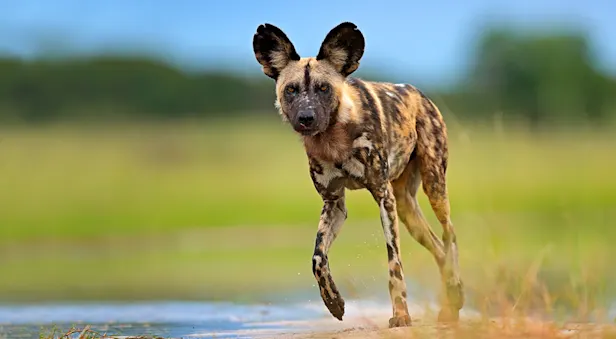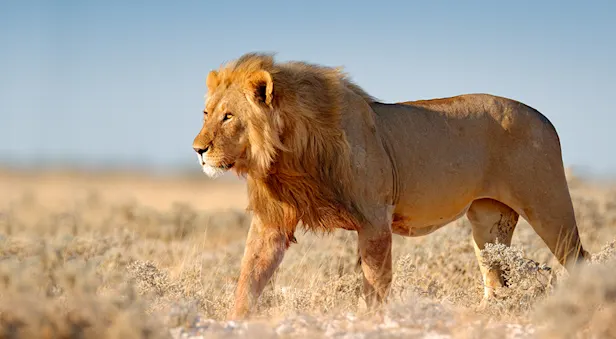Know Before You Go
African Wild Dog Facts | Southern Africa Wildlife Guide
The African wild dog, one of the world’s most endangered mammals, has recently gained a great deal of attention. Their numbers have spiraled downward so severely that drastic conservation efforts have been put into place. As of now, there are only about 6,600 left in the wild. Botswana’s northern region, in particular the Okavango Delta, is probably the best area in the world to see them; however, they are so elusive and nomadic that the chances of observing these amazing dogs, even in Botswana, are only around one in 10. To see a pack of African wild dogs is indeed a very lucky sighting!
Physical Characteristics
Adult African wild dogs are approximately the size of a Labrador retriever, but slimmer and sinewier for their size.
They weigh an average of 55 pounds.
All have brindled coats of brown, black, khaki and white, and similar black facemasks and white-tipped tails. Each dog has distinctive patterning besides these common traits.
Their rounded, oversized ears help them hear great distances.
They have extremely sharp teeth for shearing flesh, including unique, three-pronged knives called tricuspids.
Habitat
Wild dogs are typically found in savanna, grassland and woodland. Their habitats range greatly, and they have even been observed at altitudes of 18,480 feet in the snow of Kilimanjaro, Tanzania, and in the heat of deserts. These dogs are most active in the early morning and evening, lying in shade during the day.
Behavior
Wild dogs are incredibly vocal creatures. Chirps and squeaks reminiscent of bird calls are frequently heard when dogs greet each another. Agitated dogs will bark, and anxious pups sometimes give an owlish “hoo” call. Lions largely disregard wild dogs, but if they come across dogs’ kills they may attempt to chase the dogs off and feed on the carcasses.
Wild Dog Society
Wild dog packs generally comprise of five to six adults with their pups, including a dominant breeding pair. With litters averaging 10 pups and females capable of delivering up to 18, this could bring a pack to 50 members. This actually occurred in the mid-1990s at the Moremi Game Reserve in Botswana—a pack of 46 dogs formed and were so formidable, that they almost chased away all of the other predators in the area.
Feeding Habits
Packs normally hunt once a day, but will hunt more often if the group is large or if there are pups to be fed. Prey size also influences the number of hunts—a wildebeest obviously will satisfy more dogs than will a gazelle. Wild dogs will prey upon a wide array of animals but are best at hunting small to medium-sized antelopes, such as the red lechwe. In bushed and wooded habitats, they will take down warthog and even young kudu. Such species constitute most of their kills, though given the chance they will also catch antelope fawns, hatchlings, hares and other small animals. Large antelopes, such as eland, are rarely taken, and only by very large packs.
Wild dogs have suffered unfair persecution in the past. There was misconception that they are cruel creatures and even vermin; however, in reality, wild dogs are the most efficient of all African predators and the most social of all mammals. Single living dogs simply would have no chance of survival. Their success depends on the sociality of the pack. Dogs will also kill until all dogs, young and old, sick and healthy, have eaten.
Breeding
Like their hunting behavior, the breeding system for wild dogs is an example of remarkable cooperation. In each pack, only the dominant pair breeds while the other dogs help to rear their offspring. This is done for the good of the pack, since all of the dogs are related. Only the strongest genes are passed on. Breeding takes place in the middle of winter in the Okavango Delta, and this is the only time that dogs become sedentary. The gestation period lasts approximately 10 weeks, and the dominant female whelps in a den.
For the first two weeks, the female suckles the litter, spending long periods underground with the pups. After those two weeks, the pups make their first unsteady foray outside, and begin to feed on meat regurgitated for them by all of the pack members. Within six weeks or so, the pups feed on their own with the rest of the pack.Photo Credit: David Luck


























